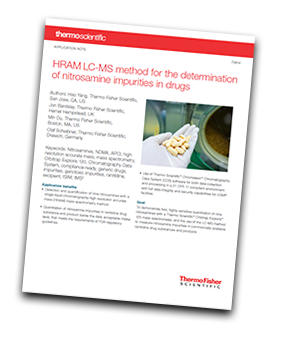This application note will enable you to detect and quantify nine nitrosamines with a single liquid chromatography-high resolution accurate mass (HRAM) mass spectrometry method.
 Goal
Goal
To demonstrate fast, highly sensitive quantitation of nine nitrosamines with a Thermo Scientific™ Orbitrap Exploris™ 120 mass spectrometer, and the use of the LC-MS method to measure nitrosamine impurities in commercially available ranitidine drug substances and products.
Introduction
What are nitrosamines?
Nitrosamines are small molecular weight chemical substances that are probable human carcinogens, and their presence in medicines is considered unacceptable by regulators. Since 2018, the United States Food and Drug Administration (US FDA) has announced a series of voluntary recalls of drug products following the detection of genotoxic nitrosamine impurities. To ensure the health and safety of the patients taking these medications,
international medicine regulatory agencies have set acceptable daily intake limits for nitrosamines. Given these low action limits, pharmaceutical manufacturers and contract testing organizations are developing methods to quantify nitrosamines in excipients, active pharmaceutical ingredients (APIs), and drug products to ensure batches do not exceed regulatory acceptance levels and enable control of impurities within their supply chains.
Experimental
Full details of the experimental conditions can be found by downloading the application note.
Results and Discussion
Selective determination of nitrosamine impurities
The method was operated in targeted selective ion monitoring (tSIM) and targeted tandem MS (tMS2) mode (previously PRM) with fast scan speed (3 Hz at 120,000 resolution setting) for optimal sensitivity and selectivity of target nitrosamines. Other than NDBA, no other endogenous interferences in blank excipient extract were observed. Although using the current gradient conditions, the method could not baseline resolve the interferent from NDBA, the amount of interferent to NDBA was <20% at 0.1 ng/mL, lowest calibrator, and insignificant at 0.5 ng/mL.
Sample extraction and recovery for the analysis of nitrosamines
A critical challenge for reliably detecting and quantifying trace levels of nitrosamine impurities in complex drug formulation matrices is the need to develop a reproducible extraction protocol to maximize sample extraction efficiency. In response to this challenge, sample recovery and reproducibility of the extraction process were evaluated by spiking the nitrosamine neat standards at 2 and 5 ng/mL levels into the blank excipient matrix before and after the extraction process.
Conclusion
A rapid, highly selective, and sensitive method was developed using the Acclaim Polar Advantage II column, Vanquish Horizon UHPLC system, Orbitrap Exploris 120 mass spectrometer, and Chromeleon CDS software for detection and quantitation of nine nitrosamines in commercially available ranitidine drug products. By combining the robust and reproducible chromatography with the 120,000 mass resolving power, fast scanning speed, and sub-ppm mass accuracy of the Orbitrap Exploris 120 system, the resultant method can provide reliable and confident quantitation of nine nitrosamine impurities to meet the September 2020 US FDA regulatory acceptance limits.
